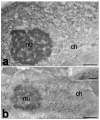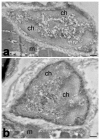Molecular and Structural Alterations of Skeletal Muscle Tissue Nuclei during Aging
- PMID: 38339110
- PMCID: PMC10855217
- DOI: 10.3390/ijms25031833
Molecular and Structural Alterations of Skeletal Muscle Tissue Nuclei during Aging
Abstract
Aging is accompanied by a progressive loss of skeletal muscle mass and strength. The mechanisms underlying this phenomenon are certainly multifactorial and still remain to be fully elucidated. Changes in the cell nucleus structure and function have been considered among the possible contributing causes. This review offers an overview of the current knowledge on skeletal muscle nuclei in aging, focusing on the impairment of nuclear pathways potentially involved in age-related muscle decline. In skeletal muscle two types of cells are present: fiber cells, constituting the contractile muscle mass and containing hundreds of myonuclei, and the satellite cells, i.e., the myogenic mononuclear stem cells occurring at the periphery of the fibers and responsible for muscle growth and repair. Research conducted on different experimental models and with different methodological approaches demonstrated that both the myonuclei and satellite cell nuclei of aged skeletal muscles undergo several structural and molecular alterations, affecting chromatin organization, gene expression, and transcriptional and post-transcriptional activities. These alterations play a key role in the impairment of muscle fiber homeostasis and regeneration, thus contributing to the age-related decrease in skeletal muscle mass and function.
Keywords: RNA processing; cell nucleus; chromatin; gene expression; myofiber; ribonucleic acid (RNA) transcription; satellite cell; skeletal muscle atrophy.
Conflict of interest statement
The authors declare no conflicts of interest.
Figures




Similar articles
-
In vivo expression patterns of MyoD, p21, and Rb proteins in myonuclei and satellite cells of denervated rat skeletal muscle.Am J Physiol Cell Physiol. 2004 Aug;287(2):C484-93. doi: 10.1152/ajpcell.00080.2004. Epub 2004 Apr 14. Am J Physiol Cell Physiol. 2004. PMID: 15084472
-
Nuclei of aged myofibres undergo structural and functional changes suggesting impairment in RNA processing.Eur J Histochem. 2009 Apr-Jun;53(2):e12. doi: 10.4081/ejh.2009.e12. Eur J Histochem. 2009. PMID: 19683983 Free PMC article.
-
Biochemical isolation of myonuclei employed to define changes to the myonuclear proteome that occur with aging.Aging Cell. 2017 Aug;16(4):738-749. doi: 10.1111/acel.12604. Epub 2017 May 23. Aging Cell. 2017. PMID: 28544616 Free PMC article.
-
Aging changes in satellite cells and their functions.Curr Aging Sci. 2011 Dec;4(3):279-97. doi: 10.2174/1874609811104030279. Curr Aging Sci. 2011. PMID: 21529324 Review.
-
The expanding roles of myonuclei in adult skeletal muscle health and function.Biochem Soc Trans. 2024 Dec 19;52(6):1-14. doi: 10.1042/BST20241637. Biochem Soc Trans. 2024. PMID: 39700019 Review.
Cited by
-
Optimizing the Preoperative Preparation of Sarcopenic Older People: The Role of Prehabilitation and Nutritional Supplementation before Knee Arthroplasty.Nutrients. 2024 Oct 12;16(20):3462. doi: 10.3390/nu16203462. Nutrients. 2024. PMID: 39458460 Free PMC article. Review.
-
The skeletal muscle proteomic determinants of neuromuscular function in young and older women following 8 weeks of resistance training.Exp Physiol. 2025 Mar;110(3):438-453. doi: 10.1113/EP092328. Epub 2024 Dec 11. Exp Physiol. 2025. PMID: 39663727 Free PMC article.
-
Impact of Glucose Profile, Fasting Insulin, and Renal Function on Sarcopenia in Elderly at Single Centered Nursing Home: A Cross-Sectional Structural Equation Model Analysis.J Multidiscip Healthc. 2025 Mar 6;18:1393-1404. doi: 10.2147/JMDH.S486370. eCollection 2025. J Multidiscip Healthc. 2025. PMID: 40066249 Free PMC article.
-
Molecular constraints of sarcopenia in the ageing muscle.Front Aging. 2025 Jul 3;6:1588014. doi: 10.3389/fragi.2025.1588014. eCollection 2025. Front Aging. 2025. PMID: 40678078 Free PMC article. Review.
-
Multiple ways to promote adult grass carp (Ctenopharyngodon idella) muscle hypertrophy: Application of dietary myo-inositol.Anim Nutr. 2025 Apr 5;21:326-340. doi: 10.1016/j.aninu.2025.01.010. eCollection 2025 Jun. Anim Nutr. 2025. PMID: 40487104 Free PMC article.
References
Publication types
MeSH terms
LinkOut - more resources
Full Text Sources

